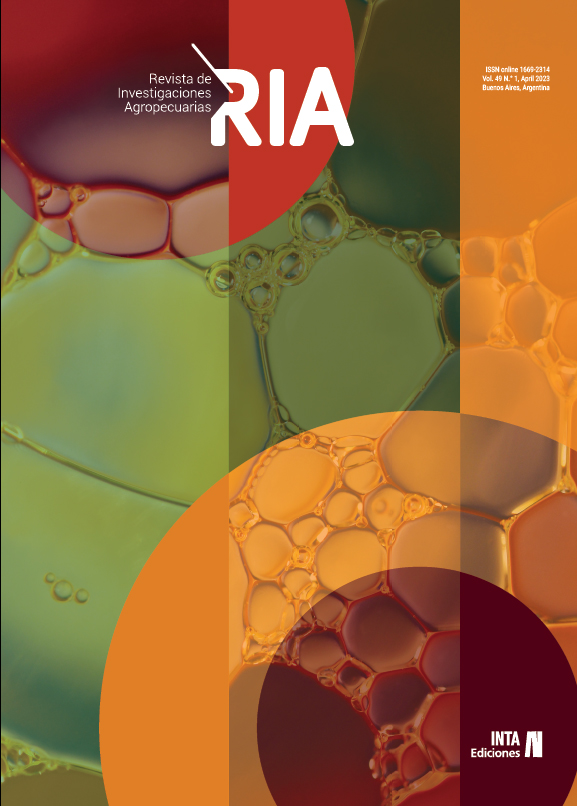Ver ítem
- xmlui.general.dspace_homeDirección Nacional y DNAsSistemas de Información, Comunicación y CalidadGerencia de Comunicación e Imagen InstitucionalArtículos científicosxmlui.ArtifactBrowser.ItemViewer.trail
- Inicio
- Dirección Nacional y DNAs
- Sistemas de Información, Comunicación y Calidad
- Gerencia de Comunicación e Imagen Institucional
- Artículos científicos
- Ver ítem
Efecto del estrés salino en el régimen hídrico, concentración de compuestos osmóticamente activos y pigmentos fotosintéticos en cultivares de tomate
Resumen
El presente trabajo tiene como objetivo identificar indicadores fisiológicos y bioquímicos para caracterizar genotipos de tomate tolerantes al estrés salino. Se estudiaron cuatro variedades (Amalia, Vyta, Campbell-28 y Claudia) en condiciones semicontroladas, un medio salinizado a base de NaCl a conductividad eléctrica (CE) de 6 dS m-1 con su respectivo control a CE=0.36 dS m-1. Se evaluaron indicadores: contenido de prolina, glicina betaína, proteínas
[ver mas...]
El presente trabajo tiene como objetivo identificar indicadores fisiológicos y bioquímicos para caracterizar genotipos de tomate tolerantes al estrés salino. Se estudiaron cuatro variedades (Amalia, Vyta, Campbell-28 y Claudia) en condiciones semicontroladas, un medio salinizado a base de NaCl a conductividad eléctrica (CE) de 6 dS m-1 con su respectivo control a CE=0.36 dS m-1. Se evaluaron indicadores: contenido de prolina, glicina betaína, proteínas solubles totales, clorofila a y carotenoides, potencial hídrico en hojas y raíces, potencial osmótico foliar y ajuste osmótico (AO). Se realizó un análisis de componentes principales (ACP) para determinar los indicadores que más contribuyen a la tolerancia a la salinidad. Existió variabilidad de respuesta en los indicadores evaluados entre el medio salino y el medio control. La prolina se incrementó entre 3 y 9 mf g-1 ms en raíces y entre 8 y 23 mg g-1 mf en hojas, demostrando la capacidad de osmorregular en función de solutos orgánicos. Las variedades Amalia y Vyta presentaron los mayores incrementos de glicina betaína (18 mg g-1 ms). Todas las variedades redujeron su potencial hídrico en condiciones de salinidad a valores menores de -0.9 MPa, en consecuencia existió un AO significativo entre las variedades, siendo Vyta y Amalia las de mayor AO. Partiendo del ACP se encontró que las variables potencial hídrico radicular y foliar, potencial osmótico, ajuste osmótico y el contenido de prolina fueron las de mayor contribución a la variabilidad total encontrada entre variedades. Vyta y Amalia resultaron las tolerantes mientras que Claudia y Campbell-28 clasificaron como susceptibles.
[Cerrar]
This work aimed to identify ecophysiological and biochemical indicators to characterize tomato genotypes tolerant to salt stress. Four varieties (Amalia, Vyta, Campbell-28 and Claudia) were studied under semi-controlled conditions, a salinized medium based on NaCl at electrical conductivity (EC) of 6 dS m-1 with their respective control at EC=0.36 dS m-1. Proline content, glycine betaine, total soluble proteins, chlorophyll and carotenoids, water
[ver mas...]
This work aimed to identify ecophysiological and biochemical indicators to characterize tomato genotypes tolerant to salt stress. Four varieties (Amalia, Vyta, Campbell-28 and Claudia) were studied under semi-controlled conditions, a salinized medium based on NaCl at electrical conductivity (EC) of 6 dS m-1 with their respective control at EC=0.36 dS m-1. Proline content, glycine betaine, total soluble proteins, chlorophyll and carotenoids, water potential in leaves and roots, leaf osmotic potential and osmotic adjustment (AO) were the evaluated variables. A principal component analysis (PCA) was carried out to determine the indicators that most contribute to salinity tolerance variability. There was a significant variability response in the evaluated indicators between the saline medium and the control medium. Proline increased between 3 and 9 mg g-1 mf in roots and between 8 and 23 mg g-1 mf in leaves, demonstrating the ability to osmoregulation in function of organic solutes. The Amalia and Vyta varieties presented the highest increases in glycine betaine (18 mg g-1 ms). All the varieties reduced their water potential under salinity conditions to values lower than -0.9 MPa, consequently there was a significant OA among the varieties, with Vita and Amalia being the ones with the highest OA. Starting from the PCA analysis, it was found that the variables root and leaf water potential, osmotic potential, os motic adjustment and proline content were the ones with the greatest contribution to the total variability found among varieties. Vyta and Amalia were tolerant varieties while Claudia and Campbell-28 classified as susceptible.
[Cerrar]

Autor
Avila, C.;
Argentel Martínez, Leandris;
Campos Posada, Raúl;
Campos Posada, Gloria E.;
Eichler-Löbermann, Bettina;
Lopez, R.;
Fuente
RIA 49 (1) : 32-40. (abril 2023)
Fecha
2023-06
Editorial
Ediciones INTA
ISSN
0325-8718
1669-2314
1669-2314
Formato
pdf
Tipo de documento
artículo
Palabras Claves
Derechos de acceso
Abierto
 Excepto donde se diga explicitamente, este item se publica bajo la siguiente descripción: Creative Commons Attribution-NonCommercial-ShareAlike 2.5 Unported (CC BY-NC-SA 2.5)
Excepto donde se diga explicitamente, este item se publica bajo la siguiente descripción: Creative Commons Attribution-NonCommercial-ShareAlike 2.5 Unported (CC BY-NC-SA 2.5)


